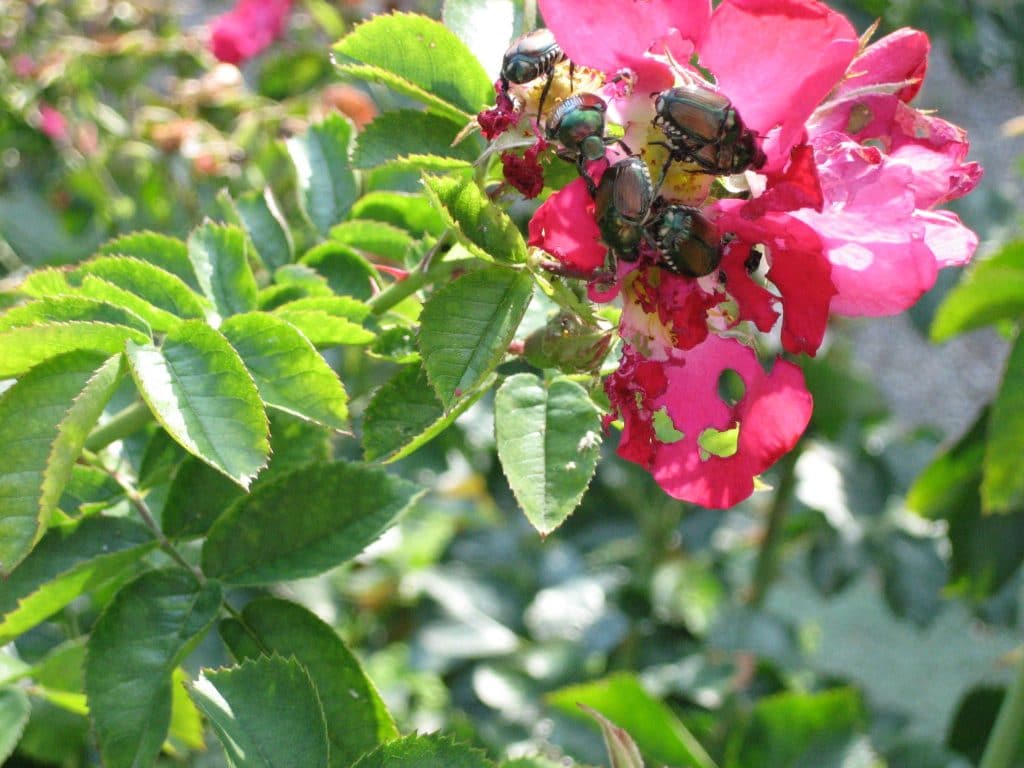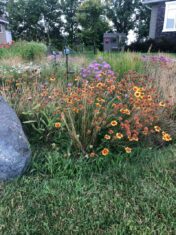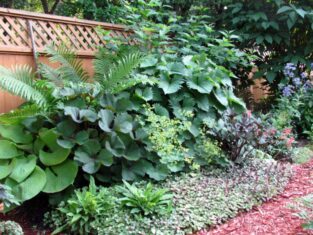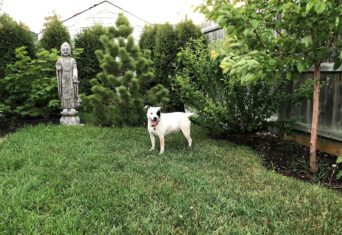
When Japanese beetles discover your garden, it can be frustrating. I stopped counting after dunking more than 300 into soapy water. The beetles enjoy eating the leaves of more than 200 different plants and trees, and in our garden they feast on one particular rose bush and a corkscrew hazel.
There seems so little one can do other than stand guard to spy the beetles and then knock them into a bucket of soapy water. If allowed in your area, some suggest spraying with neem oil. Neem oil is used as a bio-pesticide in organic farming to repel a wide variety of pests, including aphids, cabbage worm, thrips, whiteflies, mites, fungus gnats, beetles, moth larvae, mushroom flies, leafminers, caterpillers, locust and Japanese beetles.
The damage is visible on the leaves of the trees and shrubs attacked by the beetles. And there are the patches in the lawn where last year’s grubs devoured all the roots of the grass.

As summer goes on, however, the beetles have been mating and laying eggs in the soil. Those eggs will hatch in late August, and the young grubs (white, C-shaped) will be active in the soil this fall until hibernating over the winter.
How to control and minimize Japanese beetle populations
We spray the soil in September with a product called Canadian Lawn Guardian from NIC (Natural Insect Control) in Stevensville, Ont. NIC says Lawn Guardian has beneficial nematodes — microscopic worms — native to Canada, meaning they’re fresh and more targeted to Canadian pests and 100% organic. The nematodes seek out an insect host (the grubs) and release bacteria to initiate an infection. The infection causes the insect to die, and nematodes to feed and reproduce. The NIC entomologists say that the product is safe to handle and there is no harm to pets, plants or friendly insects such as ladybugs.
To target the “bad guy” grubs, Lawn Guardian is a mix of two nematodes, one that stays close to the surface (approximately three inches/8 cm) and another that goes deeper (approximately seven inches/18 cm).
I’ve asked different people why beetles seem to be on the increase. Some attribute it to Ontario’s year-old ban on pesticides, which ended the use of products that kill grubs in lawns. Sandra Mitchell, owner of NIC, says we’re on the up-curve of the natural insect cycle of beetles, and that they will be worse next year before beginning to decline. Her company has been supplying natural products for 20 years and shipping Canadian-produced nematodes since 2008. Here are some of her suggestions:
- Wait for the right timing to apply nematodes. In the fall, the grubs are small and close to the surface, so a fall application of nematodes will likely kill more grubs. But the soil must be moist to below the level of the grubs. We’ve had a relatively hot, dry summer, so wait for some soaking rains (or water deeply).
- Apply in the evening, not in direct sun, because the sun’s rays can reduce the effectiveness of the nematodes.
- After applying, water well to help flush the nematodes into the soil.
- If it’s hot, water for 2 or 3 days afterward.
- Nematodes can be applied as long as the temperature is above 10° C (50° F).
- The Lawn Guardian product has an expiry date (60 days after being made) so check the expiry date before buying. NIC also has online ordering.









I thought you might like to know there is a parasitic wasp that is starting to appear that can start to control the beetle population. Here is an excerpt from the Montréal Botanical gardens:
Ecological roles
Japanese beetles are considered crop and garden pests. The larvae damage lawns. The adults, which often feed in swarms, can skeletonize trees and shrubs. They also attack flower buds and fruit.
Mammals (moles, shrews, skunks) and birds feed on the larvae and can control their populations to some extent. Natural predators of the insect (flies and wasps) have been imported from Japan. In fact, we can now see the presence of Istocheta aldrichi, a parasitoid tachinid fly that lays its eggs on Japanese beetles. The fly larva then develops inside the Japanese beetle, resulting in its death. The larva of the fly will then turn into a pupa, always inside the beetle, where it will spend the winter. Adults emerge in spring, around the same time as Japanese beetles. If you see parasitized Japanese beetles, it is important to leave them in the wild so that this predator can continue its life cycle. This is easily recognizable by the white dots (eggs), often on the Japanese beetle’s thorax.
If you see a white dot on the head of a beetle it is a wasp egg leave these alone ,they will multiply.
Please be aware that Neem oil is not approved for use as an outdoor insecticide in Ontario. While it is a natural product, apparently there has not been sufficient scientific data to assure its use is in accordance with the Ontario pesticide ban.
Hello Lynne,
You’re absolutely right. Thank you for pointing that out. —Beckie
Pls supply site for NIC. Thanks, R. Orida
The NIC site is <a href="http://www.naturalinsectcontrol.com” target=”_blank”>www.naturalinsectcontrol.com
I live in Southeast Oakville and Japanese Bettles have destroyed my several Rose of Sharon and a large bed of tea roses this year. I was instructed by our local nursery and the wonderful woman who helps me with my large garden to simply spray vegtable oil onto the affected plants and trees and much to my surprise the attacks seem to have stopped. I have reapplied the vegtable oil twice over a period of a month.
I asked an entomologist about neem oil, specifically, whether the spraying of leaves and flowers of the attacked trees and shrubs with neem oil would create a problem for the introduction of nematodes. The reply:
"I can not find any evidence that neem oil will harm beneficial nematodes. I found a website in the U.S. that reported there is no effect on beneficial nematodes. I did find an interesting paper that neem oil will control plant parasitic nematodes."